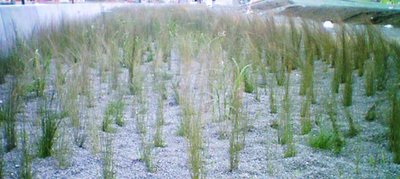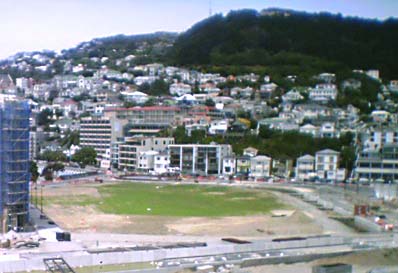Everything's gone green
Encouragingly, there is increasing support in New Zealand for buildings that use principles of Environmentally Sustainable Development (ESD). The LandCare Research Tamaki Building was something of a trailblazer, proving that in addition to the long-term savings, ESD need not cost any more upfront. Developers and marketers are now leaping at the chance to label their buildings as "green", "energy efficient" and "sustainable", but as far as I'm aware, there is no local equivalent to the American LEED or Australian Green Star rating systems, so it's hard to judge exactly what they mean by "green buildings". Here's a quick look at some of them.
...
 The old Mid City complex, stretching from Manners St to Willis St, was something of a poster child for 80s mirror-glass excess and short-sighted profit-driven development. Gerald Melling even named a book after it ("The Mid-City Crisis") and said that "it aims for the urbane but achieves the provincial".
The old Mid City complex, stretching from Manners St to Willis St, was something of a poster child for 80s mirror-glass excess and short-sighted profit-driven development. Gerald Melling even named a book after it ("The Mid-City Crisis") and said that "it aims for the urbane but achieves the provincial".Now it's being (very visibly and noisily) transformed into a new head office for the Department of Conservation, who are expected to move in late this year. Developers The Wellington Company also claim that this will be Wellington's "first green building", but it's hard to find out online exactly what the "green" features are. No doubt there'll be plenty of energy-efficiency features, and I've heard rumours of small wind turbines on the roof. In any case, the Bluebridge ferry terminal has some prior claims to being a "green building" in Wellington.
 While one rendering of the Manners St elevation shows what looks like roof gardens, they're not visible in the main image. Mind you, from the look of the Willis St elevation, nature's already been trying to create its own green roof there.
While one rendering of the Manners St elevation shows what looks like roof gardens, they're not visible in the main image. Mind you, from the look of the Willis St elevation, nature's already been trying to create its own green roof there.In addition to energy use considerations, density and access to public transport, this redevelopment has another important sustainable feature: it recycles an old building. We've become used to adaptive reuse of 19th century and early 20th century buildings, but this is the first time I've come across a radical refit of such a recent structure.
...
Just before Christmas, it was announced that the Site 7 building planned for Kumutoto will be home to Meridian Energy. They claim it to be "New Zealand's first 'green' office building", and they back this up with projections that it will use 60% less energy and 70% less water than comparable buildings, as well as incorporating solar water heating, intelligent lighting and rainwater collection.
In addition, it will be built on brownfield land close to the railway station, and is a good example of mixed use. The ground floor will be in two parts, one of which is planned to house an "interactive retail outlet" (apparently with "activities, art and artefacts [that] will intrigue and delight window shoppers and buyers alike"), and the other will have a café/takeaway outlet. As with everything on the waterfront, the granting of the lease was controversial, but simply by being here rather than in an exurban office park, this will contribute to the sustainable development of Wellington.
...
It's not just buildings that can be designed to be more environmentally friendly: parks can, as well. While there's a general perception that parks are "natural" by definition, in fact manicured lawns are artificial constructions just like buildings, and can be ecologically dead monocultures. But Waitangi Park will be different: it features wetlands that have been designed to treat stormwater and irrigate the park, as well as bringing back something like the original Waitangi Lagoon habitat. Many of the reeds have now been planted:

I've heard some complaints that there's too much concrete on Waitangi Park, but there are good reasons for the amound of hard stuff that's currently visible. For one thing, skateboarders and basketball players aren't particularly fond of grass, so those activities require some hard surfaces. Secondly, it's good to have some impervious footpath surfaces, so that people can walk around the park even when the grass is wet. But the main reason is simple: it's still under construction! There's a lot of infrastructure that's had to go in, and much of that will soon be covered by water or vegetation. In fact, the Field was sown just before Christmas, and grass has suddenly begun to sprout all over it, so all that bare earth will soon be soft and green.

It's still not easy to envisage how it will look when all the grass, reeds and trees are in place, but at least it's finally starting to look like a park.



0 Comments:
Post a Comment
<< Home